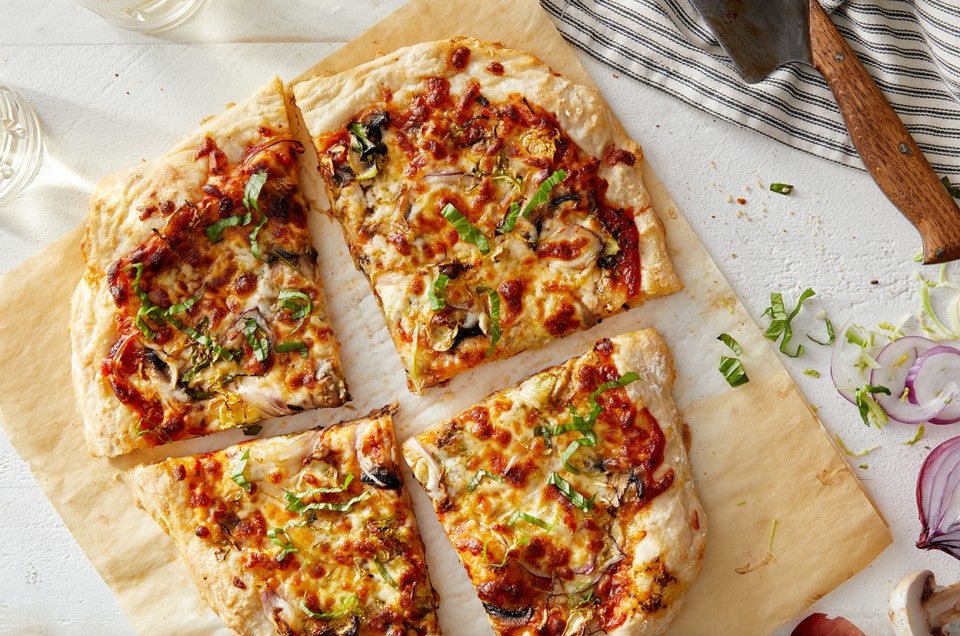


I’m not a person you’d term chic. For instance, shoes. Only recently did I learn the difference between Uggs and Huggies.
Sure, I have many pairs of shoes. Evenly divided between rubber Crocs (blue, pink, purple), and rubber boots (snow this high, snow THIS high, mud season). I've never had any desire to wear high heels. My feet and stilettos? Never the twain shall meet.
So I’m tickled on the rare occasions when chic and I cross paths. Like now, with no-knead pizza dough the hottest thing sweeping NYC since… well, since the last hottest thing to sweep NYC, whatever that was. (Foam? I know, SO ’90s…)
Jim Lahey, whose Sullivan St. Bakery has long been a chic-leader in Manhattan foodie circles, recently opened a restaurant named Co. His specialty? Over-the-top pizzas made from an overnight, no-knead dough. Anxious New Yorkers are waiting hours for the chance to sample one of these hot (both literally, and figuratively) pizzas.
No-knead pizza dough? Huh. I can do that.
Lahey’s recipe was printed in the New York Times—straightforward, to the point of confusing minimalism. The first thing I noticed was the flour/liquid ratio (hydration, in baker’s terms), which tells me how sticky the dough’s going to be. Most soft, kneadable bread doughs are about 70% to 75% hydration: the water weight is about ¾ the flour weight.
Lahey’s recipe? 96% hydration, nearly equal parts flour and water.
In other words, flour soup.
I mixed the dough. It was the consistency of cottage cheese—chunky and gloppy. Skeptically, I covered it for its overnight rest. The next day, it looked like a typical starter: bubbly and soft.
Lahey’s directions said to “place the dough on a lightly floured work surface.” Well I tell you, there was no “placing” this dough anywhere. I heavily floured my silicone rolling mat, and poured the “dough” onto it.
“Lightly sprinkle the top with flour.” I threw a handful of flour atop the dough. “Fold the dough over on itself once or twice.” I took a dough scraper and folded the mess over, and suddenly, it began to look like dough. Hey, maybe this is going to work after all…
Let’s cut to the chase; you’ll see the details below. It DID make dough. Extremely soft dough, dough that I wouldn’t shape into a big round and toss overhead—not that I ever really mastered that trick anyway. But dough that could be pressed into an erratic oval on a piece of parchment.
Dough that, when baked, yielded a crust pocked with airy holes, a crackly exterior, and great chew.
Dough that, when baked and topped with some fairly outlandish ingredients at Co. (Brussels sprouts, anyone?) becomes a $21 pizza. A price, by the way, that New Yorkers are touting as “bargain.”
Dough that, when baked in YOUR kitchen and topped with, say, pepperoni and mozzarella and tomato sauce, becomes a $6 pizza.
Ah, the cost of chic…
Read our No-Knead Pizza Crust recipe as you follow along with these pictures.
Bread flour, water, yeast, and salt.
Mix. A dough whisk is a great tool here; the gloppy dough doesn’t get stuck in the wires.
Mix some more…
…until the flour and water are totally combined.
Cover with plastic, and let rest at room temperature.
Lahey’s recipe called for a rest of up to 24 hours. I tried that, and found the dough to be too assertive, too “sour,” at least for my taste. It fought with the pizza toppings. Lahey calls for 12 hours minimum, so I let mine rest for 16 hours. It looked like this. Dough? NO WAY.
I poured it onto a heavily floured silicone mat.
After throwing more flour on top, I folded it over on itself.
Dough? OK... way.
This would have made about a 14” round, but I figured it’d be much easier to handle cut in half.
Parchment is the sticky-dough pizza maker’s best friend.
I floured the top some more…
…and was able to press it fairly thin, making a rough oval (about 8” x 12”). My pizza peel came in really handy here.
One piece went onto the hot stone…
...and the other onto the test kitchen’s Armetale bake-and-serve tray I’d been wanting to try. I happen to collect Armetale, and this piece is a beauty.
About 12 to 16 minutes later (stone vs. Armetale), the crust was beginning to brown. What, no toppings? I like to bake pizza crust pretty thoroughly before topping. Otherwise, I find I often over-cook (read, burn) whatever’s on top, while waiting for the crust to brown.
First, a layer of cheese. I like to lay down a base of cheese and then cover it with the other stuff, as cheese is more likely to char than many other types of topping.
On one pizza, roasted potatoes and caramelized onions.
On the other, pepperoni. Turkey pepperoni, which I find less greasy.
Eight minutes later, roasted potato, onion, and Brie pizza. I added the chunks of Brie in the final minute or so of baking. See, I can be chic when I want to!
And America’s #1 pizza, good ol’ pepperoni. Scattering a handful of mozzarella atop the pepperoni once the pizza comes out of the oven makes a beautifully melted topping, without a hint of rubberiness.
See that interior?
Just thought I’d show you our “photo studio.” Floor-to-ceiling windows outside our reception area provide beautiful light—for a couple of hours a day, and unless it’s snowing…
Read, rate, and review (please!) our recipe for No-Knead Pizza Crust.

